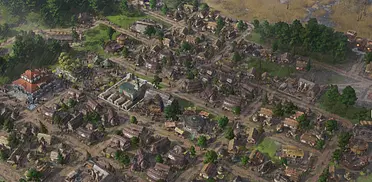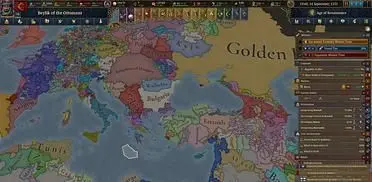After the strong success of Anno 1800, which led to renewed mainstream interest in the long-running city-building series, the announcement of a new Anno entry under Ubisoft Mainz came as no surprise. Stunning screenshots aside, we didn’t know what Anno 117: Pax Romana was going to bring to the table, so we were elated to be invited to preview the game earlier this month.
The Pax Romana (roughly spanning from 27 BC to 180 AD) was the period of Roman history characterized by “relative peace and order” that allowed the Empire to remain stable, hegemonic, and expansive. Mind you, revolts and wars were still a thing, but considering how shaky things were before and after this era for the Romans, it’s not surprising that talk of the lengthy ‘Roman peace’ stuck. By 117 AD, the Empire was greater than it’d ever been under Emperor Trajan, who died in August 9 of the same year. For this veteran RTS series, it feels like a perfect setting.
Anno is traditionally known for its focus on mostly peaceful city-building and trade, and, so far, Anno 117 is making good on the promise of bringing everything that has worked before in the series to a rich, ancient Mediterranean scenery. My three hour-ish session with the game’s Sandbox mode was welcoming and calming… until I hit some growing pains that may or may not have been related to certain missing features of the in-progress build we had access to.
After reaching a lush green Mediterranean island as a newly appointed governor with a lot to prove and even more to lose, I was tasked right away with building basic housing for the first Roman settlers and making sure food, clothes, and other basic necessities were covered. From the get-go, I was surprised by the ease of use of the building tools (iterated on since Anno 1800) and the overall clarity of the in-game menus and tutorials. While some tips and advisor dialogues lacked details at this stage of development, I didn’t feel lost at any point during the early steps, and soon a little town had grown from the docks and into the unconquered green fields and crystal-clear rivers of the region.
Like in Pharaoh and the Caesar series, it’s not enough to make money stay in the green and gradually expand your dominion with buildings which magically take care of needs. For the most part, citizens require fine clothing, adequate food, entertainment, access to goods they can buy on their own, and more. Early on, the lowest class of citizens will be more than happy with full bellies and roofs over their heads. As the town grows bigger, eventually becoming a proper city, higher levels of citizenship are unlocked, which in turn require better houses, more elaborate food dishes, and so on.
Whereas planning and building the town/city is easy as long as the requirements are met, the balancing act of providing for your citizens takes more effort and carefully meditated decisions. This is where (and why) Anno games shine, and I can safely say Pax Romana isn’t the ‘dumbed-down’ entry some veterans feared. Quite the opposite. For example, mindlessly plopping down far too many lumberjack huts and sawmills resulted in an excess of wood and timber that I couldn’t easily get rid of. That put extra pressure on warehouses and the workers tasked with moving resources around, etc. You get the idea. It’s important to take care of the city’s needs before expanding its borders, but you can’t be rash and overspend just because you have the money and materials necessary. Diversify and cover the citizens’ needs without going overboard with one industry or resource. It’s easier said than done though.
The biggest roadblock, and one that’s especially tricky to figure out if you’ve made the mistake of expanding too aggressively too fast, is that of the accumulated upkeep. All the buildings and public services worth investing in also drain money from the treasury. To counter this, more tax-paying citizens (which equals more houses) are needed, thus more markets should be carefully spread across the different zones of your city to keep the Romans’ purses light and their pantries’ full. But of course, larger populations need more security, better infrastructure, more entertainment, and whatnot. And all that costs money. It’s a no-win situation… until you turn your eye to trade.
Perhaps a big mistake of the game at this stage is that it doesn’t reinforce just how truly important hands-on trading is. While you can set your docks to auto-buy/sell below and above certain stock numbers, not every visitor is looking to sell or buy exactly what you want them to sell and buy, so ships need to be built and sent to faraway ports too. This turned out to be especially important when a higher class of citizens began asking for olive oil (we Mediterraneans love it) and I was told my olive tree plantations would be fruitless because the ground wasn’t fertile enough for those plants. The solution was to look for olives elsewhere, pay for them, and set up a long trade route that would bring them to my port. I could take care of the rest of the process with my own artisans and manufacturers though.
I’m sure that, after spending more time with the game and the full implementation of the trade system, that won’t be much of an issue as long as you plan ahead, but my play session kind of grinded to a halt when I couldn’t quite figure out why my ships couldn’t set off and follow the routes I wanted them to. The in-game tips hadn’t been particularly helpful at this stage, and all the time I’d spent on external trade meant I was neglecting all the brewing trouble in my city even if I was constantly pausing and unpausing the game.
As I suggested before, my city was facing growing pains and imbalance. It was just too expensive to ‘keep the lights on’ and people were asking for more amenities I couldn’t afford. In the final stretch, with trade failing to make me enough bank, I hurriedly tried to sell off redundant buildings, but the path to bankruptcy couldn’t be walked back. In Rome, they became enraged at my CEO-like mismanagement of the new colony after a pretty solid start. Eventually, my title of governor was rescinded and I was greeted by a game over screen, leaving the rest to my imagination.
This made me appreciate Anno 117: Pax Romana more, not less. I was too cocky and paid for my mistakes, yet the stuff that I couldn’t quite figure out wasn’t my fault; the support team that guided press members through the session said many of us had run into the same problems as we crashed into the in-progress build’s walls. But what was there wowed me in a way I wasn’t expecting. The three-hour session went by fast, and I wanted to unlock more and more upgrades that made my governing mission easier. The random quest events also added some flavour and unpredictability to a city builder that, as deep as it apparently is, could slip into monotony without enough variance in its later stages.
At the time of writing, it’s hard to predict how well the whole experience will come together when Anno 117: Pax Romana launches later this year on PC, PS5, and Xbox Series X/S, but its Sandbox mode has impressed me with a decent amount of guidance that never felt overbearing and a level of challenge and friction that’s been absent from many recent city builders. Of course, the vibrant and meticulously detailed visual presentation and simulation help make its crowded metropolises feel truly alive, but it’s all the work done on the mechanics and every underlying system I had barely begun to fully understand that made me excited to explore more of the ‘Roman peace’ that Ubisoft Mainz has been working on for the past few years.
For the latest gaming news, follow GameWatcher on BlueSky, check out our videos on YouTube, or give us a like on Facebook. We sometimes include affiliate links in our posts, which grants us a small commission, thank you. Please support independent Games Media. ❤️









